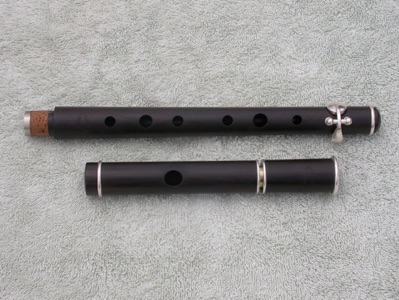Pitches

Historically, Irish traditional music seems to have been played at various pitches, mostly lower than D, something made easier by the solo nature of most performances.
In the late 19th and early 20th centuries, probably aided by the move towards ensemble playing, D became a much more common pitch and was standard by the Golden Era of 78r.p.m. recordings in the 1920s.
With regard to new versus old simple system flutes, some confusion is caused by the fact that old eight-keyed flutes are called flutes in C, because with the foot joint keys, their lowest note was C, below D.
Irish traditional players name their flutes from the note played when all six fingers are down - no matter how many keys there are on the the flute or what the lowest playable note may be.
So, below, when I talk about a flute being in F or Bb or G, I mean the note obtainable with all six basic tone holes closed.
Although the concert pitch (D) flute is by far the commonest, flutes in other pitches are made as well. For example, although it is theoretically possible to play in E flat on a fully keyed flute, because of the way Irish music is decorated, many of those decorations would be unavailable with this fingering.
The various pitches available are listed below and their uses explained:
E b
Probably the commonest pitch apart from D. A semitone higher, E flat gives a lovely brightness to the tone, and many musicians love this effect, combined with the increase in response that goes along with it.
E
I have been making flutes in E for some years now. Initially because I played an old E flute which I thought was a superb instrument, but latterly because it makes the whole job of playing in the key of A so much simpler. G fingering on this flute gives the key of A. These flutes are really responsive players without being shrill.
F
Used mostly for solo playing, or following the logic behind the E flute for playing in "A" ( actually B flat) when the session is in E flat.
Fifes

FIFE UPDATE APRIL 2017
For a good spell I had been trying to produce a quality fife that could compete price wise with the band fifes available commercially. To be honest, the competition was only in price, since the quality and playability of the cheaper instruments was frankly contemptible. On the basis of an order from local fife band, Banna Fliúit Loch a Bhogaigh, I have developed a new model of fife, made in Delrin, which I'm really excited about. It's got it's own page here.
The Piccolo
The piccolo is easily confused with with the fife, and basically the only difference between them is one of pitch. The piccolo is even higher in pitch than the fife and is normally in D, a full octave above the concert flute. The piccolo was used quite widely at one stage in the history of traditional music, in the what has become known as the "Golden Era" of traditional music in America in the 1920s. The piccolo was often used by the early American groups such as 'Dan Sullivan's Shamrock Band', where in the days before amplification it helped to produce the characteristic 'up front' sound.
The piccolo is rarely heard nowadays, but when sessions get noisy, there's nothing like a piccolo to get people to sit up and take notice! I predict a comeback.
The above flutes are all higher than concert pitch. I also make the following flutes which are lower than D, again used mostly for solo playing, although they make a very effective combination with flat pitched uilleann pipes in various keys.
C
Not to be confused with an eight keyed flute in concert pitch where the lowest note is C, this flute plays a full tone lower than concert pitch. The tone is rich and full, but the flute retains a lot of the response associated with the concert pitch instrument.
B
Really sonorous tone but in a good players hands capable of playing dance music and not just slow pieces. This pitch is commonly used in duet with low pitched uilleann pipes.
Bb
Also used for playing in duet with flat pipes, but also extensively for solo work, this is the lowest pitch normally available. Surprisingly small finger spread for such a large flute.